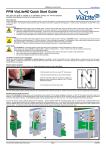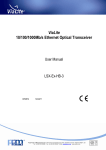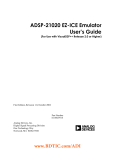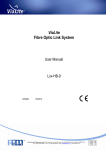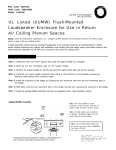Download ViaLite Metro GPS User Manual
Transcript
ViaLite Metro GPS Fibre Optic System User Manual Metro-GPS-HB-1 CR2278 13/03/06 Pulse Power & Measurement Ltd, 65 Shrivenham Hundred Business Park, Watchfield, Swindon, Wiltshire SN68TY, UK Tel +44 (0)1793 784389 Fax +44 (0)1793 784391 Email [email protected] www.vialite.co.uk PPM Limited, 2006 Contents Contents ............................................................. 3 Safety Instructions ............................................... 4 Description .......................................................... 5 Installation .......................................................... 6 The Outdoor Unit ............................................... 6 GPS Active Antenna ........................................... 7 Inside the Outdoor Housing................................. 8 Outdoor Housing Base Plate ................................ 9 Power Cable Connection ................................... 10 Fitting the Power Supply Modules ...................... 11 Fibre Handling ................................................. 12 Installing Signal Modules .................................. 16 Jumper Settings .............................................. 17 Systems ............................................................ 18 Operation .......................................................... 19 Testing During Operation .................................. 19 External LED States ......................................... 20 3 PPM Limited, 2006 Safety Instructions • • Please read the following warnings and cautions carefully before installing the system. Installation and maintenance should only be carried out by trained and qualified personnel. This equipment contains electrical connections that pose risk of electric shock. Isolate all sources of electrical supply before installing, re-siting or decommissioning this equipment. 4 PPM Limited, 2006 Description The Metro-GPS system has been designed to offer a convenient and cost-effective solution for providing GPS timing information to areas not within GPS satellite reception range. The Metro-GPS system will comprise the following parts : • • • • • • IP-65 rated external enclosure fitted with : o GPS optical transmitter module(s) o Lightning suppressor(s) [option] o Power supply modules o Wall or pole mount fixings BTS end enclosure fitted with : o GPS optical receiver module(s) o Redundancy switch module [option] GPS active antenna (s) + fixings [option] Optical cable [option] Optical cleaning kit Allen key tool This handbook covers the installation and operation of all Metro-GPS systems. For assistance with installation or use, or details of replacement parts, please consult the Metro-GPS section of the PPM website on http://www.ppm.co.uk 5 PPM Limited, 2006 Installation The Outdoor Unit The outdoor housing unit is supplied with brackets for either wall or pole mounting. The unit should not be mounted in the following locations • where it will be subject to direct jets of water, steam or submersion; • near a source of heat e.g. air-conditioning outdoor unit; • in an area where flammable gases may leak. Wall Mount Using the wall mounting bracket as a template, mark and drill where the unit will be fixed. Fix the wall mounting bracket to the outdoor housing using the screws provided and fix the unit to the wall. Pole Mount Follow the separate pole mount mechanics assembly kit (supplied). 6 PPM Limited, 2006 GPS Active Antenna The Metro-GPS product has been specifically designed to operate with the supplied GPS active antenna(s). However, it can be used with alternate antenna types with the following specification. Antenna element polarisation RHCP GPS bands L1 & L2 Impedance 50Ω LNA gain >28dB LNA feed voltage 5V or 12V LNA feed current <50mA Mounting The antennas are provided with mounting kits to affix the antenna either to a wall or to the unistrut channel provided for pole mounting. Cabling Connect the RF cable from the antenna base to the outdoor housing, ensuring that the connectors are finger tight. Wrap self-amalgamating tape around the connection to ensure there is no water ingress. 7 PPM Limited, 2006 Inside the Outdoor Housing 1 2 3 4 Key : 1. 2. 3. 4. Left-hand Power Supply Module Location Right-hand Power Supply Module Location Module Location 1 Module Location 2 Note : Disconnect the motherboard power connector before attempting to lift the hinged plate! 8 PPM Limited, 2006 Outdoor Housing Base Plate 4 5 3 Key : 1. 2. 3. 4. 5. Cable Inlet Gland Mains Inlet Gland Fibre Management Area 1 Mains Connection Point RF/Data Cable Routing Area 2 9 PPM Limited, 2006 Power Cable Connection This equipment must be earthed in accordance with the local codes. Incomplete or incorrect earthing may result in electric shock. Mains power connection is made via the cable gland on the gland plate at the base of the unit. Cables must be between 5mm and 10mm outer diameter. Step 1 Remove the transparent protective plate from over the mains connection area. Step 2 Feed the cable through the gland plate, not forgetting the gland nut and o-ring. Do not do up the gland nut at this time. Step 3 Strip the cable to reveal 5mm of conductor. Do not tin the wire prior to connection. Step 4 Connect the mains cable following the markings on the connection terminals. L = Live = Brown N = Neutral = Blue E = Earth = Green / Yellow Step 5 Refit the protective plate over the mains connection area. Step 6 Assemble and tighten the cable gland. 10 PPM Limited, 2006 Fitting the Power Supply Modules The outdoor housing can be fitted with either one or two power supply modules, the latter providing dual redundant power supply protection for the housing. The power supplies for your chosen configuration come pre-installed in the outdoor housing. Should it be necessary to replace a power supply module, remove the unit to be changed from its location. Before changing the power supply module, isolate the unit from the mains power inlet using the isolation switch adjacent to the unit. Disconnect both electrical connections from the power supply module and undo the four screws holding the power supply unit in place. Retain the screws to refit the new power supply. Locate the new module on the dowels in the base plate. Now replace the screws to hold the power supply module in place. Reconnect the electrical connections. 11 PPM Limited, 2006 Fibre Handling Fibre optic transmitters emit light in the infra-red spectrum, beyond the detection range of human vision. PPM's transmitter modules are all Class 1 radiating devices ("eye-safe") under IEC60825-1. However, as a general rule, bare fibre ends should never be examined with the naked eye, or using magnifying devices as this can cause permanent damage. Fibre optic connections to the optical modules in the outdoor housing are made on the connector block to the left of the motherboard. Fibre optic connections should not be made when there is possibility of contamination of the mating optical surface. Connections should always be cleaned before mating. The Outdoor Housing kit includes a basic cleaning kit that should be used to clean the optical connectors at the point of installation. Instructions accompany the kit. 12 PPM Limited, 2006 Minimum Band Radius All optical fibre cable has a minimum diameter beyond which it must not be bent. Cable Type 900um dia. 3mm dia. Minimum Bend Diameter 50mm 60mm 50mm 60mm 13 PPM Limited, 2006 Cable Gland Option The optical cable entry/exit point on the outdoor housing is via one of two PG7 cable glands on the gland plate. These will accommodate cables between 3mm and 6mm outer diameter. To make the cable attachment, feed the cable through the gland ensuring that the gland nut and o-ring are fitted. Tighten the gland nut only once the cables are properly terminated and situated. Make a high quality fusion fibre splice between the incoming tails and the resident connectorised pigtails. Connect the pigtails into the optical connection block, where they will mate with the pigtails from the Signal Modules. Splices and excess fibre can be stowed in the fibre management area. splice holders and fibre guides are provided to ease fibre management. 14 Self-adhesive PPM Limited, 2006 Pre-terminated Cable Option The optical cable entry/exit point on the outdoor housing is via a threaded bush on the gland plate. Once the pre-terminated fibre has been pulled into the correct location, remove the threaded pulling sock. To make the cable attachment, feed the connectorised fibre pigtails through the threaded bush and tighten. Connect the pigtails from the pre-terminated cross-site cable into the optical connection block. Excess fibre and unused fibre tails can be stowed in the fibre management area. Selfadhesive splice holders and fibre guides are provided to ease fibre management. 15 PPM Limited, 2006 Installing Signal Modules Signal modules are fitted by first locating the module onto dowels in the mounting plate, and then tightening the screws from the rear of the plate. The electrical connection to the module should be made by connecting a linking cable assembly between the motherboard and the module 14-way connectors. Finally, the optical connection should be made between the signal module and the connector block to the left of the motherboard. Where a module is not fitted, an "alarm defeat" plug should be fitted to the motherboard connector adjacent to the missing module. This will ensure that the module alarm LED does not register a false reading due to modules not fitted. 16 PPM Limited, 2006 Jumper Settings The jumpers are preset to the correct position for your particular configuration. Do not alter these settings without knowing the LNA feed requirement of your GPS antenna. Module position 1 : jumpers LK3 and LK4 Module position 2 : jumpers LK5 and LK6 Module position 3 : jumpers LK7 and LK8 Jumpers LK3, LK5 and LK7 Select LNA feed enable : pins 5 - 6 : feed connected (default) pins 1 - 2 : no feed Jumpers LK4, LK6 and LK8 Select LNA feed voltage : pins 1 - 2 : +12V feed pins 2 - 3 : +5V feed (default) Each module's jumpers can be set individually using a different voltage feed setting. 17 PPM Limited, 2006 Systems Metro-GPS can be configured in many different ways, though there are a number of standard topologies for common systems. A typical system is shown below. Metro-GPS kit 101 102 Outdoor Housing Dual PSUs Transmitters Antennas Lightning Prot. 1 1 [option] 1 [option] 2 2 [option] 2 [option] Cable option option BTS End Rack Receivers Redundancy Rx Single Housing 1 1U Shelf 2 option 18 PPM Limited, 2006 Operation Testing During Operation The outdoor housing is fitted with five green internal LEDs and a green "push to test" button. If a fault is suspected, or indicated by the external status LED, the status of both PSUs and the modules can be tested by using the "push to test" button. When the button is pressed, all LEDs should light up green. The legend for LED positions is given on the label inside the lid of the housing. If a module requires replacement, follow the installation instructions for the relevant module at the beginning of this document. If a power supply has failed, ensure the isolation switch for that PSU is switched OFF (neon not illuminated) before the module is replaced. 19 PPM Limited, 2006 External LED States The outdoor housing is fitted with an external status indicator. flashes to display the state of the equipment. There are three distinct flash rates : Periodic blinking (one flash / 2sec.) Module OK Flashing (two flashes / sec.) PSU Failure Rapid flashing Module Failure 20 The status indicator Metro-GPS User Handbook Issue 1 CR2278 ©2006 PPM Limited http://www.vialite.com





























